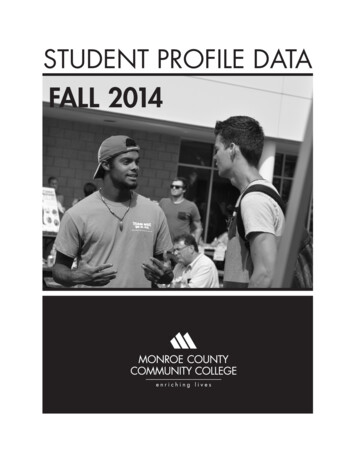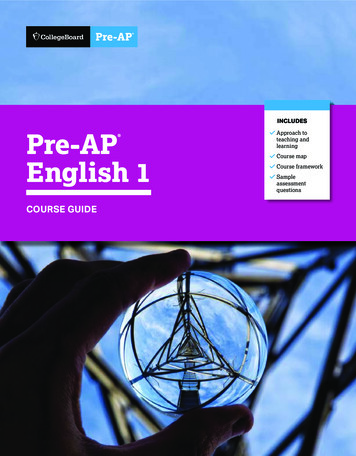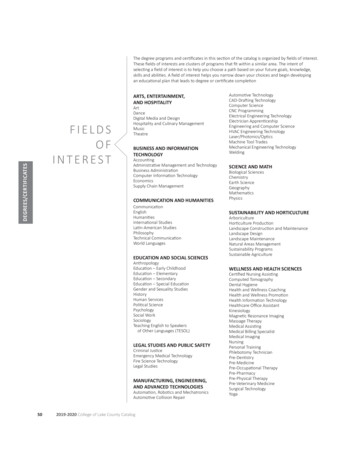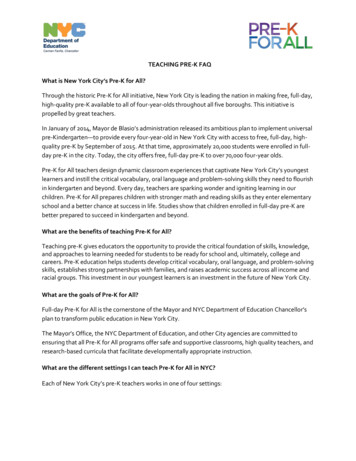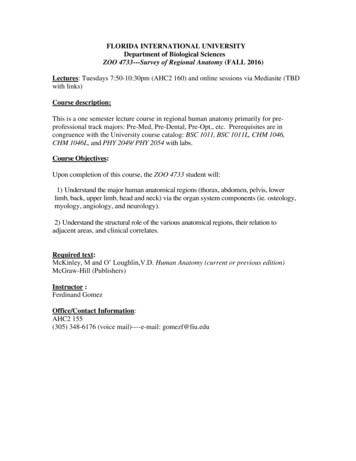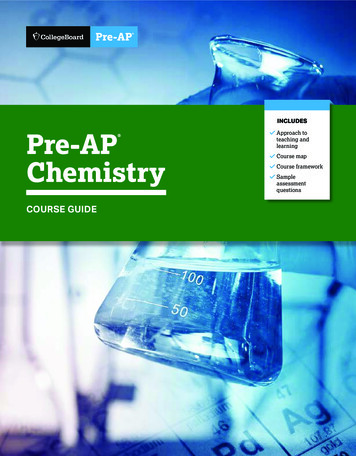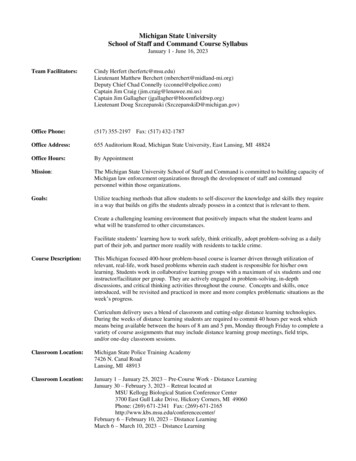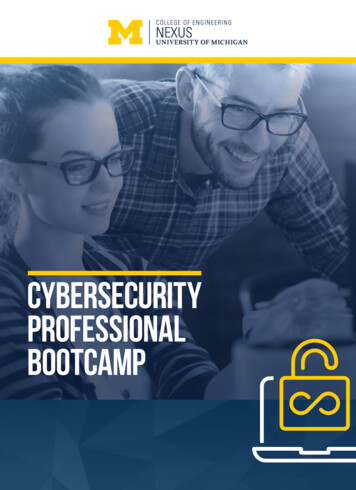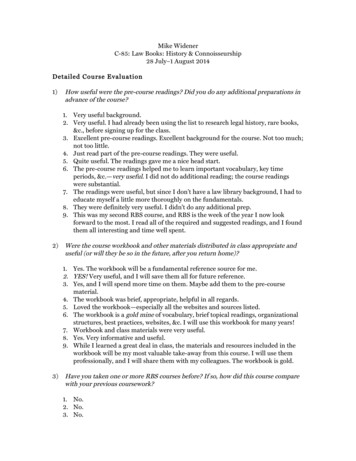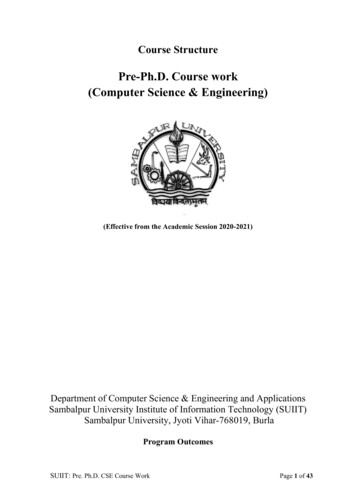
Transcription
Course StructurePre-Ph.D. Course work(Computer Science & Engineering)(Effective from the Academic Session 2020-2021)Department of Computer Science & Engineering and ApplicationsSambalpur University Institute of Information Technology (SUIIT)Sambalpur University, Jyoti Vihar-768019, BurlaProgram OutcomesSUIIT: Pre. Ph.D. CSE Course WorkPage 1 of 43
PO1PO2PO3PO4PO5PO6PO7Critical Thinking: Take informed actions after identifying the assumptions thatframe our thinking and actionsEffective Communication: Will be able to speak, read, write and listen clearly inperson and through electronic media in English and in one Indian Language.Social Interaction (Interpersonal Relation): Elicit views of others, mediatedisagreements and prepared to work in team.Entrepreneurship Capability: Demonstrate qualities to be prepared to become anentrepreneurship.Ethics: Recognize different value systems including your own, understand themoral dimensions and accept responsibility for them.Environment and Sustainability: Understand the issues of environmental contextsand sustainable development.Life-Long Learning: Acquire the ability to engage in independent and life-longlearning in the context of socio-technological changes.SUIIT: Pre. Ph.D. CSE Course WorkPage 2 of 43
Course Structure(Pre-Ph.D. Course Work in Computer Science and Engineering)Semester – ICodeCourse TitleCategoryLPTCreditsCS711Artificial IntelligenceCore Course4004CS712Core Course4004CS713Wireless Sensor Networks &ApplicationsResearch MethodologyCore Course4004CS714Research and Publication EthicsCore Course3002CS715ElectiveProgram Elective4004CS716Seminar and Research ReviewWorkReview Report (2CH)&Technical Seminar(2CH)Semester Total Credit:422LIST OF ELECTIVESS.No.Course TitleLPT1Information Security4002Data Warehousing and Data Mining4003Machine Learning4004Soft Computing4005Information Theory and Coding4006Digital Image Processing4007Mobile Computing4008Cloud Computing4009Advance Database Systems40010Advanced Computer Architecture40011Parallel and Distributed Computing40012High Performance Computing40013Big Data Analytics40014Internet of Things40015Time Series Analysis40016Combinatorial Optimization40017Neural Networks & Deep Learning40018Probability & Stochastic Process40019Natural Language Processing40020Computational Intelligence400NB:- Examination and Evaluation procedure for Technical Seminar, summer internship,Comprehensive Viva-Voce and Project Work (minor & Major) will be as per Academic &Examination Guidelines.SUIIT: Pre. Ph.D. CSE Course WorkPage 3 of 43
ARTIFICIAL INTELLIGENCECourse CodeCS 711Category:Programme Elective CoursePrerequisite:Concepts of Data structures and Design and Analysis of algorithmsObjective: CO1CO2CO3CO4L-P-T-Cr.:4004Semester:ITo learn the difference between optimal reasoning VS human like reasoning.To understand the notions of state space representation and heuristic search.To learn different knowledge representation techniques.To understand the applications of AI: namely Game playing, Theorem Proving.Expert systems, machine learning and Natural language Processing.Remember and understand the basic concepts/Principles of artificial intelligence.Analyse the Various Concepts to understand them through case studies.Apply the knowledge in understanding practical problems.Execute/Create the Project or field assignment as per the knowledge gained inthe course.UNIT – I:(10 Hours)Introduction to Artificial Intelligence, AI Problems, AI Techniques,Problems ,Problem Space and Search,Defining the problem as a state space search, Production system, Problem characteristics, Heuristicsearch Technologies: Generate and Test, Hill Climbing, Best First Search, Problem Reduction, meansend-analysis, optimal and A*, AND-OR Graphs, AO* Algorithms.UNIT – II:(12 Hours)Representation Knowledge using Predicate Logic, Representing simple facts in logic, RepresentingInstance and ISA relationships, Computable functions and Predicates, Resolution, RepresentingKnowledge using Rules, Forward Vs Backward Reasoning, Matching , Control Knowledge, , Weak slotand Filter structures, Semantic nets, Frames.UNIT – III:(12 Hours)Strong slot and Filter structures, Conceptual Dependencies, Scripts. Introduction to Non monotonicreasoning ,Logics for Non monotonic reasoning, Implementation : Depth First Search, DependencyDirected Back Tracking, Justification based Truth Maintenance Logic based Truth Maintenance systems,Statistical Reasoning, Probability and Bayes Theorem, Certainty factors, Rule based Systems, BayesianNetworks, Dempster-Shaffer Theory.UNIT – IV:(12 Hours)Minmax search, alpha-beta cutoffs, Planning system, Goal stack planning, Hierarchical Planning, NaturalLanguage Processing., Syntactic Analysis, Semantic Analysis, Discuses and Pragmatic Processing.Introduction and Fundamentals of Artificial Neural Networks, Biological Prototype, Artificial Neuron,Single Layer Artificial Neural Networks, Multilayer Artificial Neural Networks, Training of ArtificialNeural NetworksTEXT BOOKS1. Elaine Rich, Kevin Knight and ShivashankarB . Nair, Artificial Intelligence, 3/e, McGraw HillSUIIT: Pre. Ph.D. CSE Course WorkPage 4 of 43
Education, 2008.2. Neural Computing: Theory and practice- Waserman.REFERENCE BOOKS:1. Artificial Intelligence Structures and Strategies complex problem solving-George F. LugarPearson Education2. Stuart Russell and Peter Norvig, Artificial Intelligence: A Modern Approach, 2/e, PearsonEducation, 2010.3. Dan W. Patterson, Artificial Intelligence and Expert Systems, PHI.4. Neural Networks: A Comprehensive Foundation 2/e- Symen Pearson Education.WEB REFERENCES1. http://nptel.ac.in/courses/106106126/2. http://nptel.ac.in/courses/106105079/SUIIT: Pre. Ph.D. CSE Course WorkPage 5 of 43
INFORMATION SECURITYCourse CodeL-P-T-Cr.:Category:Programme Elective CoursePrerequisite:Number Theory and CryptographyObjective: CO1CO2CO3CO44004Semester:IExplain the objectives of information securityExplain the importance and application of each of confidentiality, integrity,authentication and availabilityUnderstand various cryptographic algorithms.Understand the basic categories of threats to computers and networksDescribe public-key cryptosystem.Describe the enhancements made to lPv4 by IPSecUnderstand Intrusions and intrusion detectionDiscuss the fundamental ideas of public-key cryptography.Generate and distribute a PGP key pair and use the PGP package to send anencrypted e-mail message.Discuss Web security and FirewallsRemember and understand the basic concepts/Principles of informationsecurity.Analyse the Various Concepts to understand them through case studies.Apply the knowledge in understanding practical problems.Execute/Create the Project or field assignment as per the knowledge gained inthe course.UNIT-I: CLASSICAL ENCRYPTION TECHNIQUES(08 Hours)Introduction: Cryptography, cryptanalysis, Security attacks, services & mechanisms, Symmetric CipherModel, Substitution Techniques, Transportation Techniques, Cyber threats and their defense ( PhishingDefensive measures), web based attacks, SQL injection & Defense techniques, Buffer overflow &format string vulnerabilities, TCP session hijacking (ARP attacks, route table modification) UDPhijacking ( man-in-the-middle attacks).UNIT-II: BLOCK CIPHERS , SYMMETRIC KEY CRYPTOGRAPHY & ASYMMETRIC KEYCRYPTOGRAPHY(12 Hours)Traditional Block Cipher Structure, DES,Triple DES, Block Cipher Design Principles, AES-Structure,Transformation functions, Key Expansion, Blowfish, IDEA, Block Cipher Modes of Operations. PublicKey Cryptography: Principles, public key cryptography algorithms, RSA Algorithms, Diffie HellmanKey Exchange, Elliptic Curve CryptographyUNIT-III: CRYPTOGRAPHIC HASH FUNCTIONS & DIGITAL SIGNATURES(12 Hours)Message authentication and Hash Functions, Authentication Requirements and Functions, MessageAuthentication, Hash Functions and MACs Hash and MAC Algorithms SHA-512, HMAC, DigitalSignatures, NIST Digital Signature Algorithm. Key management & distribution. User Authentication:Remote user authentication principles, KerberosUNIT –IV: USER AUTHENTICATION, TRANSPORT LAYER SECURITY & EMAILSECURITY IP SECURITY & INTRUSION DETECTION SYSTEMS(08 Hours)SUIIT: Pre. Ph.D. CSE Course WorkPage 6 of 43
Transport Level Security: Web Security Requirements, Secure Socket Layer (SSL) and Transport LayerSecurity (TLS), Secure Shell(SSH) Electronic Mail Security: Pretty Good Privacy (PGP) and S/MIME.IP Security: IP Security Overview, IP Security Architecture, Authentication Header, EncapsulatingSecurity Payload, Combining Security Associations and Key Management.Firewalls:Need for Firewall,Types of Firewall , Firewall Designing principleTEXT BOOKS:1. Cryptography and Network Security - Principles and Practice: William Stallings, PearsonEducation, 6th Edition2. Introduction to Computer Networks & Cyber Security, ChwanHwa Wu, J.David Irwin, CRCpress3. Hack Proofing your Network, Russell, Kaminsky, Forest Puppy, Wiley Dreamtech.REFERENCE BOOKS1. Cryptography and Network Security: C K Shyamala, N Harini, Dr T R Padmanabhan, WileyIndia, 1 st Edition.2. Cryptography and Network Security :ForouzanMukhopadhyay, McGraw Hill, 3rd Edition3. Information Security, Principles, and Practice: Mark Stamp, Wiley India.4. Principles of Computer Security: WM. Arthur Conklin, Greg White, TMH5. Introduction to Network Security: Neal Krawetz, Cengage Learning6. Network Security and Cryptography: Bernard Menezes, Cengage LearningWEB REFERENCES1. http://nptel.ac.in/courses/106105031/2. https://onlinecourses.nptel.ac.in/noc18 cs07/previewDATA WAREHOUSING AND DATA MININGCourse CodeL-P-T-Cr.:SUIIT: Pre. Ph.D. CSE Course Work4004Semester:IPage 7 of 43
Category:Core CoursePrerequisite:Data Structure and Algorithm, Linear Algebra, Basics of Web programmingObjective:This course deals with evolving multidimensional intelligent model from a typicalsystem, representation of multi-dimensional data for a data warehouse, discovering theknowledge imbibed in the high dimensional system, finding the hidden interestingpatterns in data, and gives the idea to evaluate various mining techniques on complexdata objects.CO1CO2CO3CO4Remember and understand the basic concepts/Principles of data warehousingand data mining.Analyse the Various Concepts to understand them through case studies.Apply the knowledge in understanding practical problems.Execute/Create the Project or field assignment as per the knowledge gained inthe course.UNIT –I: INTRODUCTION TO DATA WAREHOUSING AND ARCHITECTURE (08 Hours)Evolution of Decision Support Systems- Data warehousing Components –Building a Data warehouse,Data Warehouse and DBMS, Data marts, Metadata, Multidimensional data model, OLAP vs OLTP,OLAP operations, Data cubes, Schemas for Multidimensional Database: Stars, Snowflakes and FactconstellationsUNIT –II: DATA WAREHOUSE PROCESSAND ARCHITECTURE (08 Hours)Types of OLAP servers, 3–Tier data warehouse architecture, distributed and virtual data warehouses.Data warehouse implementation, tuning and testing of data warehouse. Data Staging (ETL) Design andDevelopment, data warehouse visualization, Data Warehouse Deployment, Maintenance, Growth,Business Intelligence Overview- Data Warehousing and Business Intelligence Trends - BusinessApplications.UNIT –III: INTRODUCTION TO DATA MINING AND CLASSIFICATIONS (14 Hours)Data mining-KDD versus data mining, Stages of the Data Mining Process-task primitives, Data MiningTechniques -Data mining knowledge representation – Data mining query languages, Integration of aData Mining System with a Data Warehouse – Issues, Data preprocessing – Data cleaning, Datatransformation, Feature selection, Dimensionality reduction, Discretization and generating concepthierarchies-Mining frequent patterns- association-correlation.Decision Tree Induction - Bayesian Classification – Rule Based Classification –Classification by Backpropagation – Support Vector Machines – Associative Classification – Lazy Learners – OtherClassification Methods.UNIT –IV: CLUSTERING,ADVANCES IN DATA MINING (10 Hours)Clustering techniques – , Partitioning methods- k-means Hierarchical Methods - distance-basedagglomerative and divisible clustering, Mining complex data objects, Spatial databases, temporaldatabases, Multimedia databases, Time series and Sequence data; Text Mining –Graph mining-webmining-Application and trends in data mining.SUIIT: Pre. Ph.D. CSE Course WorkPage 8 of 43
TEXT BOOKS:1. Jiawei Han and Micheline Kamber, Data Mining: Concepts and Techniques, MorganKaufmann Publishers, third edition2011, ISBN: 1558604898.2. Alex Berson and Stephen J. Smith, “Data Warehousing, Data Mining & OLAP”, Tata McGrawHill Edition, Tenth Reprint 2007.3. G. K. Gupta, “Introduction to Data Min Data Mining with Case Studies”, EasterEconomy Edition, Prentice Hall of India, 2006REFERENCE BOOKS:1. Mehmed kantardzic,“Datamining concepts, models, methods, and algorithms”, WileyInterscience, 2003.2. Ian Witten, Eibe Frank, Data Mining; Practical Machine Learning Tools and Techniques,third edition, Morgan Kaufmann, 2011.3. George M Marakas, Modern Data Warehousing, Mining and Visualization, Prentice Hall,2003.WEB REFERENCES1. http://www.data-miners.com/MACHINE LEARNINGCourse CodeL-P-T-Cr.:40Category:Programme Elective CoursePrerequisite:Fundamental of computer science and mathematicsObjective: 04Semester:ITo introduce concepts of learning.To know decision tree learning and various learning methods.SUIIT: Pre. Ph.D. CSE Course WorkPage 9 of 43
CO1CO2CO3CO4Remember and understand the basic concepts/Principles of machine learning.Analyse the Various Concepts to understand them through case studies.Apply the knowledge in understanding practical problems.Execute/Create the Project or field assignment as per the knowledge gained inthe course.UNIT – I:(12 Hours)General Introduction: Learning Problems, Choosing Training experience/Target Function,Representation of the target function, issues in machine learning.Concept Learning: Concept learning task-Inductive Learning, Concept Learning as search, FIND-Salgorithm, version spaces, The List then Eliminate algorithm, Representation of version spaces, TheCandidate Elimination algorithm, Inductive bias.UNIT – II:(12 Hours)Decision Tree Learning: Decision tree representation, ID3 Learning algorithm, Entropy, Informationgain, over fitting, reduced error pruning, Rule-post pruning.Bayesian Learning: Bayes’ Theorem and concept Learning, Bayes optimal classifier, Bayesian BeliefNetwork.UNIT – III:( 12Hours)Instance based Learning: Introduction, k-Nearest Neighbor Learning algorithm, distance weightednearest neighbor learning algorithm, case based reasoning, lazy learner and eager learner.Learning Set of Rules: Sequential covering algorithm, First Order Inductive Learning (FOIL),Induction as inverted deduction, Inverting resolution (First order resolution), Generalization, thetasubsumption and entailment, PROGOL.UNIT – IV:( 12Hours)Analytical Learning: Inductive vs Analytical Learning, Prolog-EBG, Combining inductive andanalytical learning.TEXT BOOKS1. Tom M. Mitchell, Machine Learning, Mac Graw HillREFERENCE BOOKS:2. Christopher M. Bishop, Machine Learning and Pattern Recognition, SpringerSUIIT: Pre. Ph.D. CSE Course WorkPage 10 of 43
SOFT COMPUTINGCourse CodeL-P-T-Cr.:4004Semester:Category:Programme Elective CoursePrerequisite:Probability and Statistics, Vectors, C /Java/ Matlab programmingObjective: CO1CO2CO3CO4ITo study the techniques of soft computing, especially evolutionarycomputation, fuzzy logic, GA and neural networks.Applying hybrid of multiple techniques and choosing the appropriatetechnique for the problems that one want to solve.Remember and understand the basic concepts/Principles of soft computingAnalyse the Various Concepts to understand them through case studies.Apply the knowledge in understanding practical problems.Execute/Create the Project or field assignment as per the knowledge gained inthe course.SUIIT: Pre. Ph.D. CSE Course WorkPage 11 of 43
UNIT-IINTRODUCTION AND ARTIFICIAL NEURAL NETWORK(12 Hours)Introduction to Soft Computing, Historical Development, Definitions, advantages and disadvantages,solution of complex real life problems.Artificial Neural Network: Introduction, basic models, Hebb's learning, Adaline, Perceptron,Multilayer feed forward network, Back propagation, Different issues regarding convergence ofMultilayer Perceptron, Competitive learning, Self-Organizing Feature Maps, Adaptive ResonanceTheory, Associative Memories, Deep Neural Network, Applications.UNIT-IIFUZZY LOGIC(12 Hours)Fuzzy Logic: Introduction to Fuzzy Logic, Classical and Fuzzy Sets: Overview of Classical Sets,Membership Function, Fuzzy rule generation. Operations on Fuzzy Sets: Compliment, Intersections,Unions, Combinations of Operations, Aggregation Operations. Fuzzy Arithmetic: Fuzzy Numbers,Linguistic Variables, Arithmetic Operations on Intervals &Numbers, Lattice of Fuzzy Numbers,Fuzzy Equations.UNIT-IIIGENETIC ALGORITHMS(12 Hours)Evolutionary and Stochastic techniques: Genetic Algorithm (GA), different operators of GA,analysis of selection operations, Hypothesis of building blocks, Schema theorem and convergence ofGenetic Algorithm, Simulated annealing and Stochastic models, Boltzmann Machine, Applications.UNIT-IVHYBRID SYSTEMS(12 Hours)Hybrid Systems: Neural-Network-Based Fuzzy Systems, Fuzzy Logic-Based Neural Networks,Genetic Algorithm for Neural Network Design and Learning, Fuzzy Logic and Genetic Algorithm forOptimization, Applications.TEXT BOOKS:1.2.3.4.Jang, “Neuro-Fuzzy and Soft computing”, Sun, Mizutani, PearsonHaykin, “Neural networks: a comprehensive foundation”,Goldberg, “Genetic Algorithms”,G.J. Klir& B. Yuan, “FuzzySets& Fuzzy Logic”, PHI.REFERENCE BOOKS:1. Anderson J.A., “An Introduction to Neural Networks”, PHI, 19992. Hertz J. Krogh, R.G. Palmer, “Introduction to the Theory of Neural Computation”, AddisonWesley, California,3. Melanie Mitchell, “An Introduction to Genetic Algorithm”, PHI, 1998.4. “Neural Networks-A Comprehensive Foundations”, Prentice-Hall International, New Jersey,1999.5. Freeman J.A. & D.M. Skapura, “Neural Networks: Algorithms, Applications and ProgrammingTechniques”, Addison Wesley, Reading, Mass, (1992).SUIIT: Pre. Ph.D. CSE Course WorkPage 12 of 43
INFORMATION THEORY AND CODINGCourse CodeL-P-T-Cr.:4004Semester:ICategory:Programme Elective CoursePrerequisite:Basics of probability theoryLearning Objective:To impart the knowledge of various error detection and correction coding techniquesused in signal transmission.CO1CO2CO3CO4Remember and understand the basic concepts/Principles of information theoryand coding.Analyse the Various Concepts to understand them through case studies.Apply the knowledge in understanding practical problems.Execute/Create the Project or field assignment as per the knowledge gained inthe course.UNIT – I:INFORMATION THEORY AND SOURCE CODING(10 Hours)Introduction to Information Theory, Uncertainty and Information, Mutual Information and Entropy,Source Coding, Huffman Coding, Shannon-Fano-Elias Coding, Arithmetic Coding, Lempel-ZivAlgorithm, Run Length Encoding, Channel Capacity, Channel Coding, Information Capacity Theorem,The Shannon Limit.SUIIT: Pre. Ph.D. CSE Course WorkPage 13 of 43
UNIT – II:ERROR CONTROL CODING (CHANNEL CODING)(10 Hours)Error Correcting Codes, Matrix Description of Linear Block Codes, Equivalent Codes, Parity CheckMatrix, Syndrome Decoding, Perfect codes, Hamming Codes, Cyclic Codes, Brust Error Correction,Fire Codes, Golay CodesUNIT – III:BCH, CONVOLUTION AND TRELLIS(10 Hours)Bose-Chaudhri Hocquenghem (BCH) codes, Decoding of BCH codes, Reed-Solomon Codes,Convolution Codes, Polynomial description , Turbo Codes , Turbo Decoding, Introduction to TCM,Performance Evaluation for AEGN Channel.UNIT – IV:COMPRESSION TECHNIQUES, AUDIO AND VIDEO CODING(10 Hours)Principle of Data Compression, Text Compression, Image Compression (GIF, TIFF, JPEG), ImageAudio Coders, Video Compression, MPEG Video Standards (MPEG 1,2,3 and MP-3 Standard Sounds.TEXT BOOKS3. Information Theory, Coding and Cryptography, Ranjan Bose 2nd Edition, The McGraw-Hill.REFERENCE BOOKS:4.5.Information theory and Coding, Norman Abramson, McGraw-Hill electronic Series.Information Coding Techniques, Dr. J. S. Chitode, Technical Publication.DIGITAL IMAGE PROCESSINGCourse CodeL-P-T-Cr.:4004Semester:ICategory:Programme Elective CoursePrerequisite:A fundamental study on matrix convention, probability theory and statistical principlesare needed to be learned.Learning Objective:The objective of the course is to understand a digital image and different processingtechniques for the better analysis of an image.CO1CO2CO3CO4Remember and understand the basic concepts/Principles of digital imageprocessing.Analyse the Various Concepts to understand them through case studies.Apply the knowledge in understanding practical problems.Execute/Create the Project or field assignment as per the knowledge gained inthe course.UNIT – I: DIGITAL IMAGE FUNDAMENTALS AND TRANSFORMS(12 Hours)Elements of visual perception: Light, Brightness adaption and discrimination, Pixels, coordinateconventions, Imaging Geometry, Image sampling and quantization Basic relationship between pixels:Basic geometric transformations-Introduction to Fourier Transform and DFT : Properties of 2D FourierTransform , FFT, Separable Image Transforms ,Walsh – Hadamard – Discrete Cosine Transform, Haar,Slant – Karhunen – Loeve transforms. Perspective Projection, Spatial Domain Filtering, sampling andquantization.SUIIT: Pre. Ph.D. CSE Course WorkPage 14 of 43
UNIT – II: IMAGE ENHANCEMENT TECHNIQUES(10 Hours)Spatial Domain methods: Basic grey level transformation, Histogram equalization, Image subtraction,Image averaging, Spatial filtering: Smoothing, sharpening filters, Laplacian filters, Frequency domainfilters : Smoothing, Sharpening filters, Homomorphic filtering.UNIT – III: IMAGE RESTORATIONAND IMAGE COMPRESSION(14 Hours)Model of Image Degradation/restoration process: Noise models,Inverse filtering, Least mean squarefiltering, Constrained least mean square filtering, Blind image restoration, Pseudo inverse, Singularvalue decomposition.Lossless compression: Variable length coding: LZW coding, Bit plane coding- predictive coding,DPCM.Lossy Compression: Transform coding – Wavelet coding – Basics of Image compression standards:JPEG, MPEG, Basics of Vector quantizationUNIT – IV: IMAGE SEGMENTATION AND REPRESENTATION(12 Hours)Edge detection: Thresholding, Region Based segmentation, Boundary representation: chair codes,Polygonal approximation, Boundary segments: boundary descriptors: Simple descriptors, Fourierdescriptors, Regional descriptors, Simple descriptors, TextureTEXT BOOKS:Digital Image Processing, 3rd Edition, by Rafael C Gonzalez and Richard E Woods. Publisher:Pearson Education.REFERENCE BOOKS:6.Fundamentals of Digital Image Processing, By Anil K JainDigital Image Processing, By William K Pratt, John Willey (2001)Image Processing Analysis and Machine Vision, By MillmanSonka, Vaclav hlavac, RogerBoyle, Broos/colic, Thompson Learniy (1999).10. Digital Image Processing and Applications, By, B. Chanda, D. DuttaMagundar, Prentice Hall ofIndia, 20007.8.9.SUIIT: Pre. Ph.D. CSE Course WorkPage 15 of 43
MOBILE COMPUTINGCourse CodeL-P-T-Cr.:40Category:Programme Elective CoursePrerequisite:Data communication and Computer NetworksObjective:CO1CO2CO3CO4 04Semester:ITo learn emerging techniques in GSM, wireless MAC.To learn mobile network and transport layer.To learn mobile database, data dissemination and MANAT protocolsRemember and understand the basic concepts/Principles of mobile computing.Analyse the Various Concepts to understand them through case studies.Apply the knowledge in understanding practical problems.Execute/Create the Project or field assignment as per the knowledge gained inthe course.UNIT – I: INTRODUCTION, GSM, WIRELESS MAC(10 Hours)Introduction to Mobile Communications and Computing: Mobile Computing (MC): Introduction to MC,novel applications, limitations, and architecture. GSM: Mobile services, System architecture, Radiointerface, Protocols, Localization and calling, Handover, Security, and New data services. WirelessMedium Access Control: Motivation for a specialized MAC (Hidden and exposed terminals, Near andfar terminals), SDMA, FDMA, TDMA, CDMA.UNIT – II: MOBILE NETWORK AND TRANSPORT LAYER(10Hours)Mobile Network Layer: Mobile IP (Goals, assumptions, entities and terminology, IP packet delivery,agent advertisement and discovery, registration, tunneling and encapsulation, Optimizations), DynamicHost Configuration Protocol (DHCP). Mobile Transport Layer : Traditional TCP, Indirect TCP,SUIIT: Pre. Ph.D. CSE Course WorkPage 16 of 43
Snooping TCP, Mobile TCP, Fast retransmit/fast recovery, Transmission /time-out freezing, Selectiveretransmission, Transaction oriented TCP.UNIT – III: MOBILE DATABASE AND DATA DISSEMINATION(10 Hours)Database Issues: Hoarding techniques, caching invalidation mechanisms, client server computing withadaptation, power-aware and context-aware computing, transactional models, query processing,recovery, and quality of service issues. Data Dissemination: Communications asymmetry, classificationof new data delivery mechanisms, push-based mechanisms, pull-based mechanisms, hybrid mechanisms,selective tuning (indexing) techniques.UNIT – IV: MANAT, PROTOCOLS(10 Hours)Mobile Ad hoc Networks (MANETs): Overview, Properties of a MANET, spectrum of MANETapplications, routing and various routing algorithms, security in MANETs.Protocols and Tools: Wireless Application Protocol-WAP. (Introduction, protocol architecture, andtreatment of protocols of all layers), Bluetooth (User scenarios, physical layer, MAC layer, networking,security, link management) and J2ME.TEXT BOOKS :11. Jochen .12. Stojmenovic and Cacute, “Handbook of Wireless Networks and Mobile Computing”REFERENCES:13. Reza Behravanfar, “Mobile Computing Principles: Designing and Developing MobileApplications with UML and XML”, ISBN: 0521817331, Cambridge University Press.14. Adelstein, Frank, Gupta, Sandeep KS, Richard III, Golden, Schwiebert, Loren, “Fundamentalsof Mobile and Pervasive Computing”, McGraw-Hill Professional.15. Hansmann, Merk, Nicklous, Stober, “Principles of Mobile Computing”, Springer.16. Martyn Mallick, “Mobile and Wireless Design Essentials”, Wiley DreamTech.SUIIT: Pre. Ph.D. CSE Course WorkPage 17 of 43
CLOUD COMPUTINGCourse CodeL-P-T-Cr.:Category:Programme Elective CoursePrerequisite:Basic Computer NetworkLearning Objective: CO1CO2CO3CO44004Semester:ITo develop the understanding of fundamentals and technological aspects ofCloud Computing.Management of cloud services.Virtualization along with various terminologies and the keywords used inCloud Computing and virtualization.Storage network design and optimization.Remember and understand the basic concepts/Principles of cloud computing.Analyse the Various Concepts to understand them through case studies.Apply the knowledge in understanding practical problems.Execute/Create the Project or field assignment as per the knowledge gained inthe course.UNIT –I:CLOUD COMPUTING FUNDAMENTALS(10 Hours)Introduction; Distributed Data Processing, Distributed Database System, Promises of DDBSs,Problem areas. Cloud Computing definition, private, and public and hybrid cloud. Cloud types; IaaS,PaaS, SaaS. Benefits and challenges of cloud computing, public vs private clouds, role of virtualizationin enabling the cloud; Business Agility: Benefits and Challenges to Cloud architecture. Applicationavailability, performance, security and disaster recoveryUNIT –II: MANAGEMENT OF CLOUD SERVICES(08 Hours)Reliability, availability and security of services deployed from the cloud. Performance and scalability ofservices, tools and technologies used to manage cloud services deployment; Cloud Economics: CloudComputing infrastructures available for implementing cloud based services.UNIT –III:VIRTUALIZED DATA CENTER ARCHITECTURE & INFORMATIONSTORAGE SECURITY & DESIGN(12 Hours)Cloud infrastructures; public, private, hybrid. Service provider interfaces; Saas, Paas, Iaas. VDCenvironments; concept, planning and design, business continuity and disaster recovery principles.Managing VDC and cloud environments and infrastructures. Storage strategy and governance; securitySUIIT: Pre. Ph.D. CSE Course WorkPage 18 of 43
and regulations. Designing secure solutions; the considerations and implementations involved. Securingstorage in virtualized and cloud environments.UNIT –IV: STORAGE NETWORK DESIGN & OPTIMIZATION OF CLOUD STORAGE(10 Hours)Architecture of storage, analysis and planning. Storage network design considerations; NAS and FCSANs, hybrid storage networking technologies (iSCSI, FCIP, FCoE), design for storage virtualization incloud computing, host system design considerations. Global storage management locations, scalability,operational efficiency. Global storage distribution; terabytes to petabytes and greaterTEXT BOOKS:1. Greg Schulz, “Cloud and Virtual Data Storage Networking”, Auerbach Publications [ISBN:978-1439851739], 2011.2. Gautam Shroff, “Enterprise Cloud Computing Technology Architecture Applications”,Cambridge University Press; 1 edition, [ISBN: 978-0521137355], 2010.REFERENCE BOOKS:1. Toby Velte, Anthony Velte, Robert Elsenpeter, “Cloud Computing, A PracticalApproach”McGraw-Hill Osborne Media; 1 edition [ISBN: 0071626948], 2009.2. Dimitris N. Chorafas, “Cloud Computing Strategies” CRC Press; 1 edition [ISBN:1439834539], 2010.3. EMC, “Information Storage and Management” Wiley; 2 edition [ISBN: 9780470294215], 2012.SUIIT: Pre. Ph.D. CSE Course WorkPage 19 of 43
ADVANCED DATABASE SYSTEMSCourse CodeL-P-T-Cr.:4004Semester:ICategory:Programme Elective CoursePrerequisite:DBMS, Computer NetworksObjective:To know advanced concepts of database in large
Cryptography and Network Security - Principles and Practice: William Stallings, Pearson Education, 6th Edition 2. Introduction to Computer Networks & Cyber Security, ChwanHwa Wu, J.David Irwin, CRC . Principles of Computer Security: WM. Arthur Conklin, Greg White, TMH 5. Introduction to Network Security: Neal Krawetz, Cengage Learning 6 .


